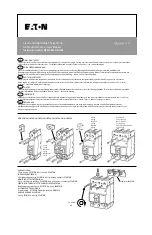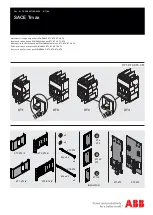
14
Instruction Book
IB182942EN July 2018 www.eaton.com
DST-2-VR
+
VR-Series
+
Replacement Circuit Breaker
Figure 4.8.d shows the circuit breaker in the closed state after the
closing springs have been recharged. The recharging of the spring
rotates the closing cam one half turn. In this position the main link
roller rides on the cylindrical portion of the cam, and the main link
does not move out of position.
4.3.3 TRIPPING OPERATION
When the trip bar “D” shaft (Figure 4.8.b, Item 9) is turned by
movement of the shunt trip clapper (11), the trip latch will slip past
the straight cut portion of the trip bar shaft and will allow the banana
link and main link roller to lower. The energy of the opening spring
and contact loading springs is released to open the main contacts.
The mechanism is in the state illustrated (Figure 4.8.b) after the
circuit breaker is tripped open.
4.3.4 TRIP-FREE OPERATION
When the manual trip button is held depressed, any attempt to close
the circuit breaker results in the closing springs discharging without
movement of the pole shaft or vacuum interrupter stem.
4.4 CONTROL SCHEMES
There are two basic control schemes for the VR-Series
+
circuit
breaker elements, one for dc control and one for ac control voltages
(Figure 4.3). Specific customer order wiring schematics and
diagrams are included with each circuit breaker.
There may be different control voltages or more than one tripping
device, but the principal mode of operation is as follows:
As soon as the control power is applied, the spring charging motor
automatically starts charging the closing spring. When the springs
are charged, the motor cut off LS1/bb switch turns the motor off.
The circuit breaker may be closed by closing the control switch close
(CS/C) contact. Automatically upon closing of the circuit breaker, the
motor starts charging the closing springs. The circuit breaker may be
tripped any time by closing the control switch (CS/T) contacts.
Note the position switch (PS1) contact in the spring release circuit
in the scheme. This contact remains closed while the circuit breaker
is being racked between the ‘Test’ and ‘Connect’ positions for
VR-Series
+
circuit breakers. Consequently, it prevents the circuit
breaker from closing automatically, even though the control close
contact may have been closed while the circuit breaker is racked to
the ‘Connect’ position.
When the CS/C contact is closed, the SR closes the circuit breaker.
If the CS/C contact is maintained after the circuit breaker closes, the
Y relay is picked up. The Y/a contact seals in Y until CS/C is opened.
The Y/b contact opens the SR circuit, so that even though the circuit
breaker would subsequently open, it could not be reclosed before
CS/C was released and remade. This is the anti-pump function.
4.4.1 TIMING
The opening and closing times for the circuit breakers vary
depending upon the control voltage, power rating, environment and
test equipment. Differences in timing are expected between initial
factory measurements and field inspections. Circuit breaker timing
can be measured by service personnel using available equipment
before installation and in conjunction with regular maintenance
periods to assist in tracking the general health of the circuit breaker.
Typical ranges as observed using nominal control voltages are listed
in Table 4.
Tablt 4. Timt Ptr Evtnt
Event
Milliseconds
Closing Time
(From Initiation of Close Signal to Contact Make)
45 - 60
Opening Time
(Initiation of Trip Signal to Contact Break)
30 - 38
Reclosing Time
(Initiation of Trip Signal to Contact Make)
140 - 165
otte:
N
Values are typical at nominal rated control voltage(s).
4.5 SECONDARY CONNECTION BLOCK
The breaker control circuit is connected to the switchgear control
through secondary connection block (Figure 3.3.b). The contacts
engage automatically when the breaker is racked into the “test” and
“connect” positions. The socket half of the connection is located in
the cubicle and a jumper of multiconductor cable can complete the
control connections (for testing) when the breaker is withdrawn from
the cell.
4.6 INTERLOCKS
WARNING
INTERLOCKS ARE PROTECTIVE DEVICES FOR PERSONNEL AND
EQUIPMENT. DO NOT BYPASS, MODIFY, OR MAKE INOPERATIVE ANY
INTERLOCKS. DOING SO COULD CAUSE DEATH, SERIOUS PERSONAL
INJURY, AND/OR PROPERTY DAMAGE.
There are several interlocks built into the VR-Series
+
vacuum
replacement breakers. Each of these interlocks, though different in
form, duplicate or exceed in function that of the original breaker.
These interlocks exist to safeguard personnel and equipment. The
basic premise behind the interlocking arrangement on the vacuum
replacement breaker is that the breaker must not be inserted into
or removed from a live circuit while the main contacts are closed.
Also considered in the interlocking is that the breaker should pose
no greater risk than necessary to the operator in or out of the cell.
In addition to the original interlocks, VR-Series
+
breakers provide an
anti-close interlock.
4.6.1 ANTI-CLOSE INTERLOCK
The anti-close interlock prevents discharging of the closing springs if
the breaker is already closed (Figure 4.5, Item 11). When the breaker
is closed, the interlock component moves away from the spring
release clapper so that it cannot lift the spring release latch (9).
4.6.2 SHUTTER OPERATING MECHANISM
Each breaker cell is equipped with a shutter to shield the high
voltage stabs in the cubicle when the breaker is not in the cubicle.
The shutter is regulated by the shutter operating mechanism located
on the right side of the breaker. This mechanism opens the shutter
as the breaker is racked into the cell and closes the shutter as the
breaker is racked out of the cell.







































